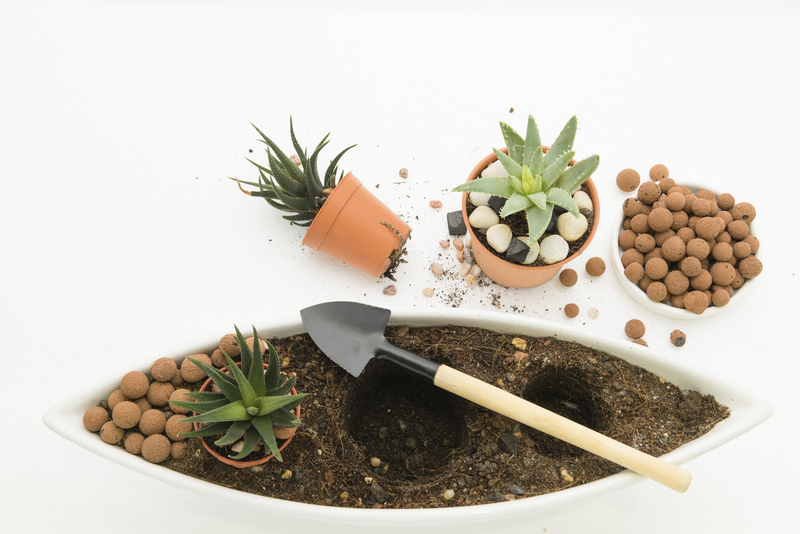Gardening: A Simple Step Towards Climate Change Mitigation
Posted on 27/08/2025
Gardening: A Simple Step Towards Climate Change Mitigation
Climate change is undoubtedly one of the most pressing issues faced by humanity today. While large-scale industrial strategies are critical, small-scale climate change mitigation actions at the household level are just as essential. Gardening, often seen as a pleasant pastime, can become a powerful tool in the effort to combat global warming. In this comprehensive guide, we'll explore how gardening contributes to climate action, practical steps to start your own climate-friendly garden, and more.
Understanding Climate Change and Why Every Action Matters
Before delving into gardening for climate change mitigation, it's essential to understand the basic mechanisms behind climate change and why even small steps can make a difference.
- Rising greenhouse gas emissions--primarily carbon dioxide (CO2), methane (CH4), and nitrous oxide (N2O)--are driving global temperature increases.
- Deforestation, soil depletion, and the loss of green cover are significant contributors to greenhouse gas emissions.
- Mitigation strategies focus on reducing emissions, enhancing carbon sequestration, and increasing community resilience.
Every individual action counts. The collective impact of thousands--even millions--of people making eco-conscious choices like maintaining a garden has the potential to slow climate change meaningfully.

The Connection Between Gardening and Climate Change Mitigation
How does gardening help combat climate change? The answer lies in the powerful ecological services gardens provide. Let's explore some key pathways where home and community gardens play a vital role:
1. Carbon Sequestration Through Plants and Soil
Plants absorb carbon dioxide (CO2) through the process of photosynthesis, storing it in their stems, leaves, roots, and, ultimately, in the soil. The more green cover we have--even if it's just in a small backyard or balcony--the more carbon is taken out of the atmosphere.
- Trees and shrubs sequester more carbon over time; include them in your gardening plan.
- Garden soil, when enriched with organic matter, becomes a long-term carbon sink.
2. Reducing Food Miles with Homegrown Produce
Did you know the average processed food item travels over 1,500 miles from farm to plate? By growing your own fruits, vegetables, and herbs, you dramatically cut the emissions associated with food transport and packaging.
- Homegrown produce eliminates or lowers reliance on fossil-fuel intensive supply chains.
- Excess harvests can be shared with neighbors, further spreading the benefit.
3. Increasing Biodiversity for Climate Resilience
Healthy gardens support pollinators, birds, insects, and microorganisms--creating biodiverse mini-ecosystems that are more resilient to climate stresses.
- Biodiverse gardens have healthier soil and plant communities that recover quickly from drought and disease.
- Supporting native species improves the overall ecosystem's ability to adapt to climate shocks.
4. Managing Water and Reducing Urban Heat
Paved surfaces absorb and radiate heat--a phenomenon known as the urban heat island effect. Gardens, on the other hand, cool the environment and help with rainwater management.
- Plants absorb and store water, reducing runoff and lowering the risk of flash floods.
- Green spaces cool cities, improving comfort and energy savings for nearby homes.
5. Composting: Recycling Organic Matter
Rather than sending kitchen scraps and garden waste to landfills (where they generate methane, a potent greenhouse gas), composting transforms waste into valuable soil amendment while reducing emissions.
- Compost enriches soil, improving water retention and plant health.
- It sequesters carbon in soil for years, naturally lowering atmospheric CO2.
How to Start a Climate-Friendly Garden
Gardening for climate mitigation doesn't require a vast plot of land or advanced skills. Here is a detailed step-by-step approach to maximizing your garden's environmental impact:
1. Plan Your Space for Maximum Impact
Assess the available area, sunlight, and existing plants. No space is too small; container gardens or rooftop planters can be just as effective.
- Vertical gardening maximizes greenery in limited spaces.
- Strategically place trees and shrubs to shade your home and reduce energy costs.
2. Choose Native and Climate-Resilient Plants
Select native species, which require less water and are better suited to local conditions. Drought-resistant and perennial plants are especially useful in a warming world.
- Native plants attract pollinators and support local wildlife.
- Perennial vegetables and herbs provide food year after year, eliminating yearly re-planting emissions.
3. Prioritize Organic and Regenerative Practices
Skip synthetic fertilizers and pesticides. These cause pollution, degrade soil, and are energy-intensive to produce. Regenerative gardening methods are a win both for the planet and your plants.
- Mulch to control weeds, preserve soil moisture, and add organic matter.
- Use cover crops and crop rotations to foster soil fertility and carbon capture.
4. Compost and Recycle Green Waste
Set up a home composting system, recycling all appropriate kitchen and garden waste. This limits landfill emissions and boosts your garden's ability to store carbon.
5. Collect and Save Water
- Install rain barrels to capture and reuse rainwater for irrigation.
- Group plants by watering needs and use drip irrigation to minimize waste.
6. Design for Wildlife
Include flowering plants, berry bushes, and sheltering shrubs that attract beneficial insects and birds. Healthy ecosystem gardens are better at withstanding climate extremes.
The Role of Urban and Community Gardens in Mitigating Climate Change
Urban areas are often the epicenter of heat, pollution, and limited green space. Community gardening initiatives have emerged worldwide as incredible allies in the fight against climate change.
- They provide fresh, local food to underserved populations.
- Community spaces foster environmental stewardship and education.
- Urban gardens create vital corridors for pollinators, cooling microclimates, and reducing city-wide emissions.
Case Studies: Urban Gardening for Climate Solutions
- Victory Gardens in the USA: During WWII, millions of Americans grew their own food, dramatically reducing pressure on transportation and food systems.
- Seoul, South Korea: Rooftop and community gardens are credited with lowering local temperatures and providing green relief amidst dense skyscrapers.
Gardening for Climate: More Than Just Carbon Reduction
While tackling greenhouse gas emissions is critical, climate mitigation gardens also deliver wide-ranging co-benefits to society:
- Improved air quality: Plants filter harmful particulates from the air.
- Enhanced mental and physical health: Gardening reduces stress and promotes well-being.
- Food security: Homegrown produce bolsters resilience against food price shocks and supply disruptions.
- Community engagement: Shared green spaces strengthen social ties and foster collaboration on sustainability goals.
Frequently Asked Questions (FAQ) About Gardening and Climate Change
Q: Is gardening really enough to make a difference for the climate?
While gardening alone can't solve the global climate crisis, it's a crucial piece of the puzzle. Every square meter of green, biodiverse space helps restore balance, support wildlife, and remove carbon from the atmosphere.
Q: What are the best plants for climate-friendly gardening?
Opt for natives, perennials, trees, and shrubs. Edible crops, drought-tolerant species, and flowering plants for pollinators top the list.
Q: Can apartment dwellers contribute to climate mitigation through gardening?
Absolutely! Balcony gardens, window boxes, rooftop planters, and joining community gardens are all effective strategies.
Q: How do I get started if I've never gardened before?
Start small: grow herbs in pots, try a raised bed, or volunteer at a local garden. There are abundant online tutorials, books, and local resources to support beginners.

Tips to Maximize Your Garden's Climate Impact
- Layer your garden: Combine trees, shrubs, and groundcovers for a forest-like, multi-story effect that sequesters more carbon.
- Avoid chemical fertilizers and pesticides: Use organic methods to support healthy soil and minimize pollution emissions.
- Plant year-round: Include winter crops, cover crops, and evergreens to keep carbon cycling ongoing.
- Save seeds and swap with neighbors: Promotes local resilience and biodiversity.
Conclusion: Gardening as a Vehicle for Hope and Change
Climate change can feel overwhelming, but remember: meaningful change often starts one seed, one garden at a time. By transforming your backyard, balcony, or community lot into a climate action garden, you're taking a direct step towards a healthier planet. Every compost pile, native flower, and home-grown vegetable represents a small but essential victory in the global movement for climate change mitigation.
So, grab your trowel, plant a seed, and join the global movement to fight climate change--right from your own soil.
Additional Resources
- U.S. Environmental Protection Agency: Climate Change
- Royal Horticultural Society: Gardening and Climate Change
- Green America: Gardening and Climate Action
Interested in learning more? Explore our other articles on sustainable living, urban gardening, and eco-friendly practices to further your impact and inspire your community!

